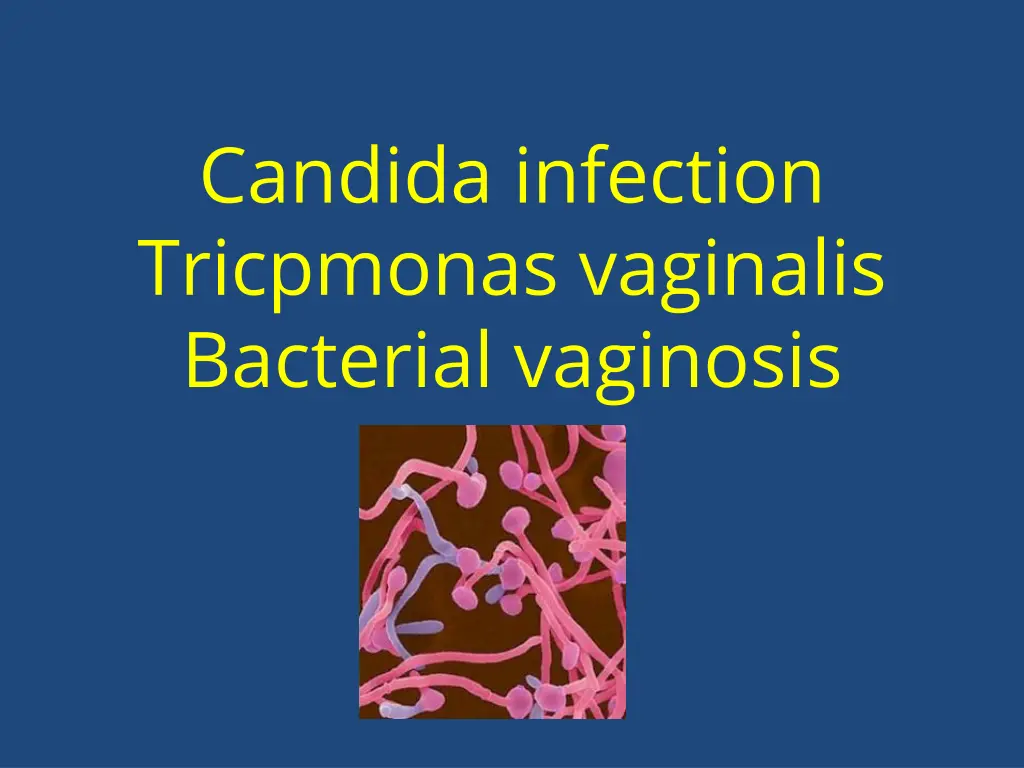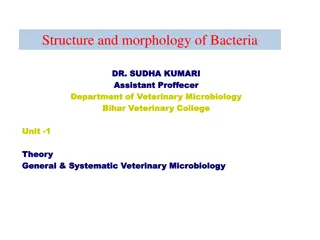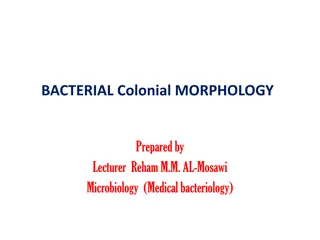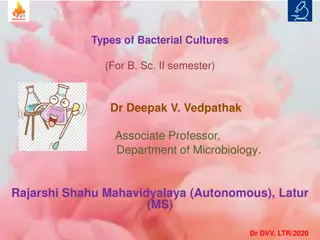
Understanding Vaginal Infections and Health
Learn about different types of vaginal infections, symptoms, examination procedures, and characteristics of normal vaginal secretions. Explore the human vagina's microbiota and common pathogens, helping you recognize and address issues related to vaginal health.
Download Presentation

Please find below an Image/Link to download the presentation.
The content on the website is provided AS IS for your information and personal use only. It may not be sold, licensed, or shared on other websites without obtaining consent from the author. If you encounter any issues during the download, it is possible that the publisher has removed the file from their server.
You are allowed to download the files provided on this website for personal or commercial use, subject to the condition that they are used lawfully. All files are the property of their respective owners.
The content on the website is provided AS IS for your information and personal use only. It may not be sold, licensed, or shared on other websites without obtaining consent from the author.
E N D
Presentation Transcript
Candida infection Tricpmonas vaginalis Bacterial vaginosis
Type of infection Males Urethritis Epididymitis Prostatitis Genital ulcers Females Cervicitis Vulvovaginitis Urethritis Bacterial vaginosis (BV) Salpingitis (pelvic inflammatory disease [PID]) Endometritis Genital ulcers Pregnant females Disease in the neonate. Children and postmenopausal women
Abnormal vaginal secretion Normal physiological vaginal secretion Vaginal infection Trichimoniasis Vulvovaginitis candiasis Bacterial vaginnosis Desquamative inflammatory vaginitis Cervicitis Infectious Noninfectious Esterogen deficiency
History & symptoms of valvovaginitis General medical Hx Allergies DM Malignancies Immunodeficiecy Medication OCP<steroids,duches Symptoms Discharge(quality scanty)physiological OCP Oder(BV,FB,EV fistula) Valvular disconfort(HSV) Dyspareunia Abdominal pain (tricho) PID General gyneclogical history( age Neonatal ,pregnancy,prepubescent ,atrophic post menop) Onset,,Esterogen depletion) Menstrual history Pregnancy Sexual Hx Contraception Sexual relationship Prior infection
Examination Breast Adequate illumination Magnification if possible Give a patient mirror Inspect external genetalia Lesions Erythema Vaginal mucosa Erythema Lesion Secretion Examination of cervix Ectropion Lesions Erythema Endocervical secretion Collect cervical and vaginal specimen Bimanual examination
Characteristic of normal vaginal secretion Desquamated vaginal epithelial cell Lactobacilli dominate PH 3.5 to 4.6 Oderless No itching or irritation Deonot soil underclothing1
The human vagina Lactobacilli Corynebacterium spp. Gardnerella vaginalis coagulase-negative staphylococci, Staphylococcus aureus Streptococcus agalactiae Enterococcus spp. Escherichia coli Anaerobes Yeasts Lined with 25 layers of epithelium cells. Separation of microbial pathogens from the normal genital microbiota.
Cassification of vulvovaginitis Complicated Underlying illness HIV DM Recurrent infection 4 or more per year Non albican candida Pregnancy Sever infection Culture confirmation mandatory Antifungal suscep. Testing Treat for 10-14 days with vaginal or oral agent Other topical Boric acid 5 fluorocytocine Consider treatment of the partners Long term suppressive treatment for frequently recurrent diseases Uncomplicated Sporadic No underlying disease By Candida albican Not pregnanat Mild to moderate severity Any available topical agent Fluconazole 150mg as a single oral dose
Candida infections yeast infection moniliasis Candidiasis or thrush is a fungal infection (mycosis) of any of the Candida species (yeasts) of which Candida albicans is the most common. Common superficial infections of skin and mucosal membranes by Candida causing local inflammation and discomfort.
Candidal vulvovaginitis vaginal thrush Infection of the vagina s mucous membranes by Candida albicans. 75% of adult women Found naturally in the vagina Hormonal changes Change in vaginal acidity. Broad-spectrum antibiotics. Use of corticosteroid medications Pregnancy. 20-30 years Poorly controlled diabetes mellitus.
Risk factors Antibiotics Pregnancy Diabetes (poorly controlled) Immunodeficiency Contraceptives Sexual behaviour Tight-fitting clothing Female hygiene
Symptoms Vulval itching Vulval soreness and irritation Superficial dyspareunia. Dysuria Odourless vaginal discharge thin and watery or thick and white (cheese-like) Erythema (redness) Fissuring satellite lesions.
Types of candidal vulvovaginitis Uncomplicated thrush single episode/less than four episodes in a year. mild or moderate symptoms caused by the Candida albicans . Complicated thrush four or more episodes in a year. severe symptoms. Pregnancy poorly controlled diabetes/immune deficiency. not caused by the Candida albicans
Diagnosis History & symptoms physical and pelvic exam Candidiasis can be similar to other diseases: Sexually transmitted diseases Chlamydia Trichomoniasis Bcterial vaginosis Gonorrhea
Treatment Butoconazole cream Clotrimazole 1% cream vaginal tablet Miconazole 2% cream vagina suppository Nystatin vaginal tablet Oral Agent: Fluconazole- oral one tablet in single dose
Treatment Short-course topical formulations single dose and regimens of 1 3 days effectively treat uncomplicated candidal vulvovaginitis Topical azole drugs are more effective than nystatin Azole drugs relief of symptoms in 80% 90% of cases. Treatment failure In up to 20% of cases If the symptoms do not clear within 7 14 days
Trichomoniasis (sexually-transmitted infection) Symptoms Purulent vaginal discharge yellow or greenish in color Vulvar irritation (strawberry) Dysurea Dyspareunia Abnormal vaginal odor The wet mount's fast results
Culture is considered the gold standard for the diagnosis of trichomoniasis. Its disadvantages include cost and prolonged time before diagnosis
Management Confirm the diagnosis Wet preparation (miss 30%) Culture Gram Stain Confirm all current sexual partners treated Oral metronidazole 500 mg bid for 7 days 2 g daily for 3-5 days If Rx failure -Consultation with experts Susceptibility testing Higher dose of metronidazole Alternative Tinidazole
Bacterial Vaginosis Floral imbalance Lactobacilli Compete with other microorganisms for adherence to epithelial cells Produce antimicrobial compounds such as organic acids (which lower the vaginal pH) hydrogen peroxide, and bacteriocin-like substances Lactobacillus acidophilus Gardnerella vaginalis Mycoplasma hominis Mobiluncus species Anaerobes Bacteroides (Porphyromonas) Peptostreptococcus Fusobacterium Prevotella
Pathogenesis Marked reduction in lactobacillus Decreased hydrogen peroxide production Polymicrobial superficial infection: overgrowth of G. vaginalis and anaerobic bacteria Lactobacilli predominate after metronidazole treatment
Epidemiology The most common vaginal infection in women of childbearing age-29% Risk factors Multiple or new sexual partners (sexual activity alteration of vaginal pH) Early age of first sexual intercourse Douching Cigarette smoking Use of IUD *Although sexual activity is a risk factor for the infection, bacterial vaginosis can occur in women who have never had vaginal intercourse
Clinical Features Most cases (50-75%) Homogenous grey vaginal discharge Dysuria and dyspareunia rare Pruritus and inflammation are absent Fishy vaginal discharge During menstruation After intercourse Minimal itching or irritation Absence of inflammation is the basis of the term "vaginosis" rather than vaginitis
Diagnostic Methods Clinical/Microscopic Criteria Gram Stain ( Gold Standard ) Clue cells on saline wet mount of vaginal discharge (on >20% cells) Bacteria adhered to epithelial cells; most reliable single indicator Vaginal pH > 4.5 Elevated pH and increased amine Sensitivity 87%; Specificity 92% *Culture- poor predictive value for G. vaginalis as prevalent in healthy asymptomatic women *DNA probes- expensive, poor predictive value alone
Treatment Recommendations Oral metronidazole 500 mg bid x 7 days ($5) 84-96% cure rate Single dose therapy (2g) may be less effective Oral Clindamycin 300 mg bid x 7 days ($28) Less effective Topical treatments (higher recurrence rates) Metronidazole gel (0.75%) 5 g PV qhs x 5 days ($30) 70-80% cure rate Clindamycin cream (2%) 5 g PV qhs x 7 days ($31) Less effective May lead to Clindamycin resistant anaerobic bacteria
Specimen Obtained during gynecological examination Vaginal secretion PH Saline wet preparation KOH wet preparation Cervical cultural and non cultural GC C.trachomatis Vaginal culture Candida Trichomonas vaginalis Cervical cytological examination if not documented within previous 12 months
Routine bacterial cultures Routine NOT helpful Wet mount- 60% sensitive (Trichomoniasis ,BV ) Abnormal or foul odor using a (KOH) "whiff test," The Gram stain is useful to diagnose BV Using the Nugent scoring system A wet mount+ a yeast culture and Trichomonas culture Recommended tests to diagnose vaginitis. Performing only a wet mount, without yeast or Trichomonas culture, 50% of either of these agents of vaginitis will be missed A sensitive DNA probe assay is available Combines the detection of yeasts, Trichomonas, and G. vaginalis as a marker for BV






















